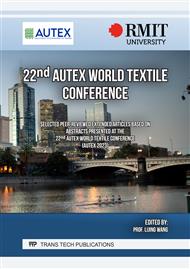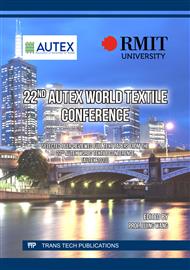[1]
E. Sharma, "Adaptation of Indian Folk Paintings for Designing and Digital Printing of Apparels Using Computer Aided Designing," International Journal of Applied Research, vol. 1, no. 9, p.989–995, 2015.
Google Scholar
[2]
A. Russell, The Fundamentals of Printed Textile Design. Worthing: AVA Publishing, 2011.
Google Scholar
[3]
J. R. Campbell and J. Parsons, "Taking Advantage of The Design Potential of Digital Printing Technology For Apparel," Journal of Textile and Apparel, Technology and Management, vol. 4, no. 3, p.1–10, 2005.
Google Scholar
[4]
C. Anyanwu, C. C. Chukueggu, and S. A. Orubu, "Textile design and traditional cultural properties in Nigeria: A batik textile exploration," Journal of African History, Culture and Arts, vol. 2, no. 2, p.104–109, 2022.
DOI: 10.57040/jahca.v2i2.218
Google Scholar
[5]
P. I. Cyril-Egware, "Design for the environment: Nembe Se in the Niger Delta region of Nigeria and its cultural heritage as resource for sustainability in the 21st century," IOSR Journal of Humanities and Social Science, vol. 21, no. 8, p.10–18, 2016.
DOI: 10.9790/0837-2108111018
Google Scholar
[6]
M. Barnard, Fashion as Communication, 2nd ed. Abingdon: Routledge, 2002.
Google Scholar
[7]
H. L. Woodget, P. Macbeth, R. Annable, and J. Pearson, "The use of embellishment techniques with ink jet printed repeated designs," in INTEDEC 2003: International Textile Design and Engineering Conference, 2003.
Google Scholar
[8]
H. M. N. Mostafa, "A philosophical Vision to Enhance the Insurance and Heritage Information Value for Designing the New Egyptian Polymer Banknotes," vol. 0, no. 0, p.0–0, Jan. 2021.
DOI: 10.21608/mjaf.2020.29020.1595
Google Scholar
[9]
T. V. Morgan, "Sociocultural materials and visual art: A functional analysis of Nigerian banknotes, 1973–2009," Cogent Arts Humanit, vol. 3, no. 1, p.1121036, Dec. 2016.
DOI: 10.1080/23311983.2015.1121036
Google Scholar
[10]
C. Wennerlind, "Money Talks, but What Is It Saying? Semiotics of Money and Social Control," J Econ Issues, vol. 35, no. 3, p.557–574, Sep. 2001, doi: 10.1080/00213624. 2001.11506390.
DOI: 10.1080/00213624.2001.11506390
Google Scholar
[11]
Ian Woodward, Understanding Material Culture, 1st ed. SAGE Publications Ltd, 2007.
Google Scholar
[12]
S. Pearce, "The construction and analysis of the cultural heritage: Some thoughts," International Journal of Heritage Studies, vol. 4, no. 1, p.1–9, Jan. 1998.
DOI: 10.1080/13527259808722215
Google Scholar
[13]
M. Saffira, "Effect of Narrative with Cross-cultural Innovation as Cultural Heritage Branding Strategy," Atlantic Press SARL, 2021.
DOI: 10.2991/assehr.k.211228.027
Google Scholar
[14]
Willemien Visser, The Cognitive Artifacts of Designing, 1st ed. Milton Park: CRC Press, Routledge, 2006.
Google Scholar
[15]
K. Dorst, "The core of 'design thinking' and its application," Interpreting Design Thinking, vol. 32, no. 6, p.521–532, 2011.
DOI: 10.1016/j.destud.2011.07.006
Google Scholar
[16]
R. Wolniak, "The Design Thinking Method and Its Stages," SYSTEMY WSPOMAGANIA W INŻYNIERII PRODUKCJI Inżynieria Systemów Technicznych, vol. 6, no. 6, p.247–255, 2017.
Google Scholar
[17]
J. W. Cresswell, Handbook of Educational Policy. Elsevier, 1999.
Google Scholar
[18]
M. NIAZ, "A Rationale for Mixed Methods (Integrative) Research Programmes in Education," Journal of Philosophy of Education, vol. 42, no. 2, p.287–305, May 2008.
DOI: 10.1111/j.1467-9752.2008.00625.x
Google Scholar
[19]
J. C. Greene, V. J. Caracelli, and W. F. Graham, "Toward a conceptual framework for mixed-method evaluation design," Educational Evaluation and Policy Analysis, vol. 11, no. 3, p.255–274, 1989.
DOI: 10.3102/01623737011003255
Google Scholar
[20]
"Mixed Methods Research," Harvard Catalyst, 2023. https://catalyst.harvard.edu/community-engagement/mmr/ (accessed Sep. 02, 2023).
Google Scholar
[21]
H. Hassan and N. Anshun, "Benefits of Digital Printing for Fashion Entrepreneurs: A Case Study at Alia Bastamam," in 2022 International Visualization, Informatics and Technology Conference (IVIT), IEEE, Nov. 2022, p.161–164.
DOI: 10.1109/IVIT55443.2022.10033381
Google Scholar
[22]
H. Ryall, "An Exploration of Digital Technology over a Number of Manipulated Textiles," University of Huddersfield, 2010.
Google Scholar
[23]
S. Arora, "Effect of printing on physical properties of muga silk fabric with reactive and acid dyes," International Journal of Home Science, vol. 2, no. 3, p.20–23, 2016.
Google Scholar
[24]
D. Dereje and J. Zhou, "Analyzing the cultural background of textile designers on their innovative thinking," Proceedings of International Conference on Education Technology and Management Science (ICETMS), p.1238–1242, 2013.
DOI: 10.2991/icetms.2013.201
Google Scholar
[25]
W. Badoe, K. Samadu, and C. Frimpong, "Exploration of Innovative Techniques in Printed Textile Design," International Journal of Innovative Research & Development, vol. 4, no. 10, p.199–211, 2015.
Google Scholar
[26]
M. Bowles and C. Isaac, Digital Textile Design. London: Laurence King, 2012.
Google Scholar
[27]
W. Lyche and P. øverjordet, "New Manual and Digital Exploration In Surface Textile Design: A Superuser Approach in Design Education," International Conference on Engineering and Product Design Education, 2021.
DOI: 10.35199/epde.2021.82
Google Scholar



